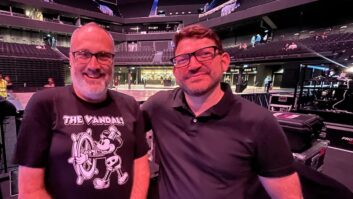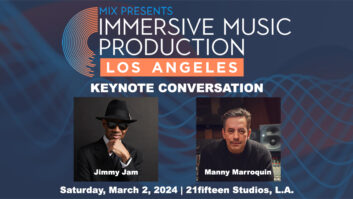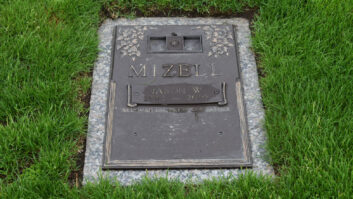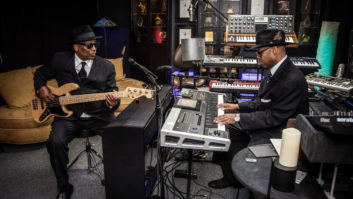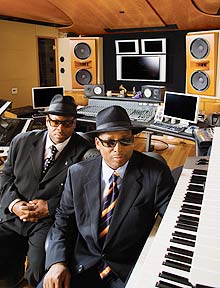
Jam (left) and Lewis in Jam’s studio, which includes an SSL AWS 900, Pro Tools and, of course, a TR-808
Photo: Mitch Tobias
The walls of Flyte Tyme studios tell a story. Here, at Jimmy Jam and Terry Lewis’ Santa Monica, Calif., facility, Gold records line the hallway: Janet Jackson, Michael Jackson, TLC, Boyz II Men, Usher — the list goes on. A glass case overflows with Grammy awards, ASCAP Awards, a Billboard Award, an NAACP Award. A plaque commemorates a star on the Hollywood Walk of Fame. And there are the dozens of pictures of the duo posing with a who’s who of R&B and pop legends — always looking sharp in their signature bespoke suits and crisp fedoras.
Upstairs, five studios buzz with activity. In one room, Asian pop sensation Tiana Xiao is tracking her latest album; in another, work is being done on The Time’s upcoming release. Four years after moving to Los Angeles and two years after settling into their own digs, it’s clear that the pair is working harder than ever and business is good.
It’s been more than 35 years since these R&B/pop icons first connected as high school students. Although their roots were in performing — the two founded Minneapolis funk band Flyte Tyme, which evolved into The Time — their work on the S.O.S. Band’s hit “Just Be Good to Me” put them on the production map, and after collaborating with Janet Jackson on her 1986 smash Control, their careers skyrocketed. Jam and Lewis became one of the most successful and influential songwriting/production teams of the ’80s and ’90s, shaping the pop sounds of those decades and laying the groundwork for pop and R&B music made today.
The sheer number of hits they’ve produced is staggering: 100 Gold, Platinum and multi-Platinum albums; 16 Number One pop singles; 26 Number One R&B singles. Just as far-reaching is the diversity of talent they’ve fostered, from Mariah Carey to Sting, from Mary J. Blige to Bryan Adams.
These days, Jam and Lewis continue to produce music and are involved in various business ventures including a record label and a publishing company — and Jam is heavily involved in industry outreach through his role as Chairman of the Board of the Recording Academy.
California Love
Various factors contributed to the duo’s decision to move to Los Angeles from Minneapolis: Travel became difficult post-9/11, clients wanted to work in a warmer climate, and opportunities simply abounded out West. “The idea was to be able to have more spontaneity in who we worked with, and just more efficiency as far as getting people into the studio,” says Jam. “I remember we went through a period of time when I was still in Minneapolis and Terry was out in L.A. [at The Village]. And Terry would be working on two or three projects at the same time, and I’d be working on one. And Terry would go, ‘Jam, you need to come to L.A., man; it’s jumping out here!’”
Jam says that downsizing from their sprawling Minneapolis facility to their temporary home on the third floor of The Village taught them the importance of streamlining workflow in comfortable surroundings. “So the thought of this place was, we want to have an environment where people want to hang out, feel comfortable; intimate rooms, where if you’re just writing with another person, you’re fine,” says Jam. “And then utilize the fact that we’re in L.A. — we didn’t do a huge room because there’s many huge rooms around L.A. to do huge string sessions or huge choir sessions.
“Basically, we took what we had in Minneapolis — which was five rooms, an office space, a recreation area in 30,000 square feet — and we’ve done the same thing here in about 9,000 square feet,” he continues. “We made choices — like for instance, there’s a 2-inch tape machine, but rather than doing one for all five rooms, we did one tape machine. And everything’s tie-lined.”
For the most part, production has transitioned to digital with a few exceptions: when resurrecting old Time archives, for example, or working with artists such as Blige, who prefers to mix down to analog. “She likes the sound and somehow that feels like a finished master to her, so we have a nice Studer machine just for that,” says Jam. The studio is equipped with Pro Tools rigs and SSL AWS 900’s, which Jam says offer the “best of both worlds; it gives you a Pro Tools controller, as well as it’s just a sound board. One of my pet peeves is that I hated walking into a room and I would hit a keyboard and nothing would happen, and someone would say, ‘Oh wait, let me get the Pro Tools up.’”
Both agree that focusing on extreme detail can block the creative flow. “The engineer, a lot of times, we’ll say, ‘Bring that vocal up,’ and he’ll go, ‘How many dB?’” says Jam. “I don’t know, just turn it up. I don’t know the difference between 1 dB and 3 dB, but I’ll know it when I hear it.”
Jam is also amused by the way DAWs allow engineers to work from a visual perspective: “We always like to have drama in our productions. The songs always start off at a lower point, and then we’re adding to it so the song grows; the beginning doesn’t sound like the end,” he says. “And we had a couple of younger engineers come in, and somebody said, ‘You know what’s cool about your songs? The waveforms always start off kind of little and then they get bigger,’ and I’m thinking, ‘What does that have to do with how it sounds?’” Adds Lewis: “I don’t believe in old school, new school; I believe in school. You just need to learn. Because three plus three has been the same math forever. You gotta learn the basics because one day you might not have the technology. Then what do you do?”
Digital technology has certainly changed the way they collaborate, from iChatting to exchanging tracks remotely — which can make it difficult to strike a balance between emotional process and intellectual process. “Music really stopped being emotional when we started getting synthesized instruments anyway,” says Lewis. “Because then we could separate; one person could sit at home and make a whole track. When we first started out playing instruments, we needed a drummer, a keyboard player, a bass player; they’d all have to be in the room at the same time, so it was always that personal, emotional interaction.” “A great band is like a great conversation,” adds Jam. “When you’re with a group of people and the conversation is just flowing, and it’s maybe a serious conversation, and then the jokes start flowing back and forth and somebody adds two cents here and two cents here — that’s what a collaboration of a band is.”
Music Matters Most
Jam and Lewis work for the love of the art, and the business supports that. But that’s not to say they don’t play the game. “Music is the soundtrack of life,” explains Lewis. “If you go outside, there’s music in the air — you hear the birds tweeting, the cars, the rumble of just the air itself. That’s all musical; it’s all melody, it’s all rhythmic. But when you take it and put it in a format that you try to sell — you make it an industry — there has to be business. There have to be dynamics and rules and things that make it acceptable or palatable, and knowable by all so everybody can work the commerce. But we made music when it wasn’t business; it was just a hobby, it was just something that we love to do. We’d pay to do it if it didn’t pay us. I always say, ‘If you love music, it will love you back.’”
“I’ve heard Terry say that,” adds Jam, “and a lot of times, when he does say it, it’s to record company people who rather than listening to what the actual record is, they’re too busy trying to think about the marketing. Listen, if the music isn’t there, then all the rest of the stuff doesn’t matter.
“In the recording industry, the guys who were great music guys, who had great ears and had great passion, a lot of those people either aren’t around or they’re working independently, but they’re not really working under the major structure anymore,” continues Jam. “And those jobs have been replaced, it seems, with a lot of lawyers and accountants, and people that think about, ‘How much is this going to sell?’ rather than, ‘Wow, what a great song.’”
These days, the entrepreneurs are gone, laments Lewis. “The music business was built by entrepreneurs: It was a guy who had an affinity for music, who had an affinity for a particular artist. That guy would go find that artist, pay for everything out of his own pocket and would know the process through and through. And when they would go to market with it, there would be a marketing plan because you lived with it the whole way. Now it’s very impersonal. You can turn your record in at the last minute, and in two days, somebody says, ‘I like it,’ ‘I don’t like it’ nobody’s involved anymore. And it totally changed the whole fabric of the industry.
“It’s like a microcosm of America,” Lewis continues. “It was an entrepreneur spirit that built America, and those were the people who were guiding America the right way. Now the record companies are the way they are because there’s no Herb Alpert, no Mo Austin — there’s not the same entrepreneurial spirit there. It’s just a guy who says, ‘What’s hot?’ ‘Who you know?’ ‘Here’s some money, go do it!’ American music, especially African-American music, is the only indigenous art form in this country. But then you take that and you take the people who love that out of the equation, what do you think you’re going to get?”
These days, Jam and Lewis focus heavily on giving back to the community. As Chairman of the Board of the Recording Academy, Jam attended both political conventions as a nonpartisan ambassador to keep music part of the discussion. And Flyte Tyme recently hosted a Grammy camp experience, giving 60 kids a chance to experience studio life. “The responsibility we have is a divine responsibility because we’ve been blessed to be able to do it for so long; the giveback now is at the forefront of our lives,” says Jam. “We want to get kids excited about the possibilities that are out there. We are very privileged to be in the position we are in.”
Sarah Jones is the editor at Mix.

